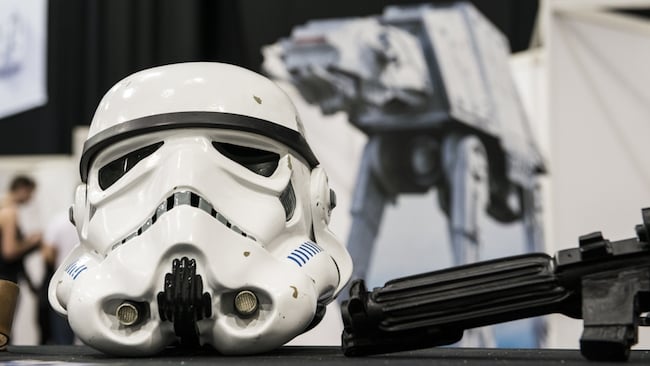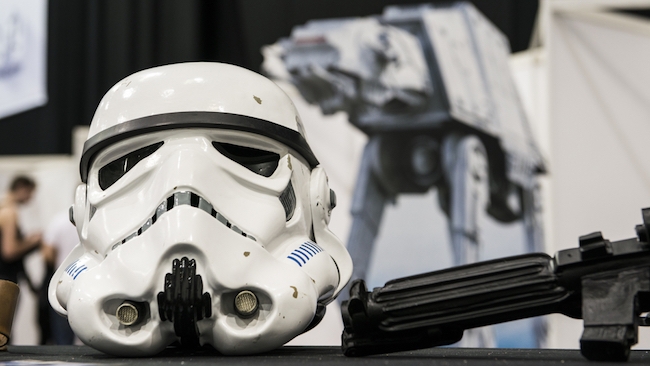

Replay: Guest contributor Joe Foster of Shoot HD takes us back to 2002 to chronicle the making of Star Wars: Attack of the Clones and the digital revolution that infiltrated Hollywood.
The year is 2002. The Winter Olympics are being held in Salt Lake City, Utah. Queen Elizabeth celebrates her Golden Jubilee. And Michael Jackson's youngest is introduced to the world via a very high balcony. Meanwhile, in Hollywood, a maverick filmmaker shakes the world of cinematography forever.
George Walton Lucas, Jr., entrepreneurial filmmaker, creator of Star Wars and Indiana Jones and industrial empire builder, drop-kicked Hollywood into the digital age with the release of Star Wars Episode II: Attack of the Clones – the first major Hollywood blockbuster to be shot 100% digitally. Though not technically the first film to do so (that honor goes to 2001's Jackpot), it would nevertheless shake up the cinematography status quo and divide the industry.
Although digital cinematography is no longer a unique concept, with all our Alexas, Dragons and Mark II's at our disposal, back in 2002, Clones encouraged a trend that we take very much for granted – for better or for worse, depending on your point of view.
Clones capture
Episode II was shot on Sony's HDW F900 (the 'Panavised' version was known as the F900F). It was a collaborative effort started back in 1997 by Sony and Panavision and would kick-start Sony's CineAlta camera line, resulting in the F55 and F65 in use today. Lucas had planned to film his entire prequel trilogy using this new gadgetry, but it was unfortunately not ready in time. For 1999's Star Wars Episode I: The Phantom Menace, George had to make do filming his blue and green screens on good old-fashioned 35mm Arriflex 435E's and Arriflex 535B's (plus a digital Sony HDC-750 for good measure). In fact, Episode I would be the last Star Wars movie shot on film until The Force Awakens opens at the end of this year.
The F900, unlike other digital cameras at that time, shot footage at 24P in HD when most, including Phantom Menace's HDC-750, would only shoot at 25P or above. It was a 2/3 3-CCD EFP camera, which captured 3:1 compressed 1440 x 1080 component video, recording onto cassette. Recording was achieved at a 1.78:1 (16:9) aspect ratio and would be cropped, altered and shoved around a 2.35:1 final release widescreen ratio. Unlike Phantom Menace (and 1983's Return of the Jedi), it was also shot with classic Panavision Primo anamorphic lenses, just as Lucas did on the first two Star Wars movies. It seemed that even when the world of cinematography was changing, some snippets of tradition remained.
This effort to maintain filmmaking tradition was expanded to the crew and work practices on set as well. Fred Meyers (the go-to HD engineer at ILM) was not only in charge of making sure the new digital workflow ran smoothly, but also worked with Lucas to maintain all the traditional feature film roles and eliminate any 'culture shocks' the crew might experience. Although new roles were added to the mix – a digital camera engineer, someone to maintain the monitoring and recording equipment (DIT anyone?) – the traditional roles were kept the same. There was still a DP, some assistants, operators, etc. Meyers even kept much of these new roles hidden off-set, so the look and feel of the set didn't feel "broadcasty."
Opposing camps
Whilst keeping an amicable foot firmly in on-set tradition and despite the push towards the eventual digital revolution, Lucas had yet to convince everyone. His efforts to replace traditional film theatre projectors with flashy new digital equipment failed to catch on – at least initially. The master image was less than 1920x1080 and was recorded with letterbox; this meant that, unfortunately as is the case with digital masters in general, 1440x1080 would remain 1440x1080 until the end of time. Of course, there still were (and still are) the celluloid faithful, with directors such as Quentin Tarantino, Steven Spielberg and Christopher Nolan, and cinematographers such as Dan Mindel, Wally Pfister and Janusz Kaminski, arguing the superiority of the film format (dynamic range, detail and set discipline are just a few examples) and expressing reluctance to embrace a digital future.
On the other side of the battlefield, however, are the filmmakers who took a leaf from Lucas's big book of 1's and 0's. Cinematographers such as Anthony Dod Mantle (who won the first Oscar for Best Cinematography for a digital feature) have migrated to the digital realm. Martin Scorsese, who ironically created The Film Foundation, also made the switch and his 2013 feature The Wolf of Wall Street became the first to not produce a 35mm print for cinemas. James Cameron would go on to utilize the Sony CineAlta HDC-F950 for his 2009 3D-fest, Avatar, and remain a digital advocate to this day. Other examples are the Oscar-winning cinematographer Roger Deakins and New Zealand film giant Peter Jackson.
Digital Pioneer
Lucas was not the first to utilize digital camera technology in films. He was not part of the Danish Dogme 95 movement in the 90's and Episode II was not the first film made digitally. His contribution was to make the Hollywood system take digital seriously. When he boldly abandoned the film format, some filmmakers questioned digital's advantages over celluloid and its place in the industry. Other filmmakers saw opportunities the format could achieve and rolled with it.
The merits and comparisons to film will most likely still be debated, even if the film format eventually disappears. Some will prefer one or the other; some will enjoy the benefits of both. Ultimately, it's the work that filmmakers do with the technology at their disposal that's important. Cinematographer Janusz Kaminski sums this up when he once said, "I think there is more to cinematography than talking about cameras and film stock. It's like talking to a costume designer about what kind of sewing machine they use."
Whilst digital revolution has very much arrived, it has not quite conquered the industry just yet. Meanwhile Star Wars: The Force Awakens, shot on 35mm, opens later this year….
Graphic by Shutterstock.com
Tags: Technology


Comments